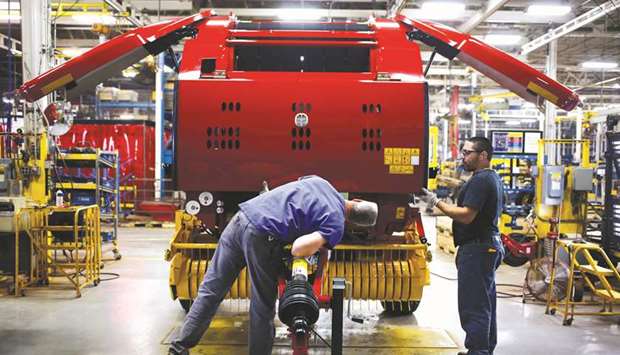US manufacturing output fell for a second straight month in February and factory activity in New York state hit nearly a two-year low this month, offering further evidence of a sharp slowdown in economic growth early in the first quarter.
The reports yesterday extended the streak of weak data and underscored the Federal Reserve’s “patient” stance towards further interest rate increases this year. Fed officials are scheduled to meet next Tuesday and Wednesday to assess the economy and deliberate on the future course of monetary policy.
The US central bank raised rates four times last year.
“The economy is spinning its wheels and not gaining any traction yet in this soft patch produced by trade wars and stock market turbulence and the government shutdown,” said Chris Rupkey, chief economist at MUFG in New York.
“Thank God Fed officials were smart enough to take their foot off the rate hikes accelerator.”
The Fed said manufacturing production dropped 0.4% last month, held down by declines in the output of motor vehicles, machinery and furniture.
Data for January was revised up to show output at factories falling 0.5% instead of slumping 0.9% as previously reported. It was the first back-to-back decline since mid-2017.
Economists polled by Reuters had forecast manufacturing output rising 0.3% in February. Production at factories increased 1.0% in February from a year ago. Manufacturing accounts for about 12% of the economy.
Motor vehicles and parts output slipped 0.1% last month after tumbling 7.6% in January.
Excluding motor vehicles and parts, manufacturing output fell 0.4% last month, the largest decrease in nearly a year. February’s drop in manufacturing production added to soft reports ranging from retail sales to housing in suggesting the economy lost significant momentum early in the first quarter. The Atlanta Fed is forecasting gross domestic product will rise at a 0.4% annualised rate in the first quarter.
GDP grew at a 2.6% pace in the fourth quarter. The economy is losing steam as the stimulus from last year’s $1.5tn tax cut package fades.
Activity is also being crimped by a trade war between the United States and China as well as by last year’s surge in the dollar and softening global economic growth, which are hurting exports.
These factors, together with a 35-day partial shutdown of the US government that ended on Jan. 25, have spilled over to the manufacturing sector.
In a separate report on Friday, the New York Fed said its general business conditions index fell 5.1 points to a reading of 3.7 in February, the lowest since May 2017. It was the third consecutive monthly reading below 10, which the New York Fed said suggested “that growth has remained quite a bit slower so far this year than it was for most of 2018.”
A reading above zero indicates expansion in the region’s manufacturing sector. The survey’s new orders index fell 4.5 points to 3.0 in March.
The weakness reported by the New York Fed also suggests that national factory activity remained sluggish this month after slowing sharply in February.
The Institute for Supply Management (ISM) reported this month that its measure of national manufacturing activity dropped to more than a two-year low in February, with a steep decline in the new orders component.
The dollar was weaker against a basket of currencies yesterday, while US Treasury prices rose. Stocks on Wall Street were trading higher. But there was some good economic news. In a third report yesterday, the University of Michigan said its consumer sentiment index rose to a reading of 97.8 in early March from 93.8 in February.
Strong consumer sentiment bodes well for consumer spending in the months ahead after spending appeared to have retrenched early in the first quarter.
A fourth report from the Labor Department showed job openings, a measure of labor demand, rose by 102,000 to a seasonally adjusted 7.58mn in January.
That was not far from the record high 7.63mn in November.
The high level of vacancies suggests a shortage of workers that could further boost wage growth.

Workers review an assembled New Holland round baler at the company’s Haytools factory in Pennsylvania (file). US manufacturing output fell for a second straight month in February and factory activity in New York state hit nearly a two-year low this month, offering further evidence of a sharp slowdown in economic growth early in the first quarter.


